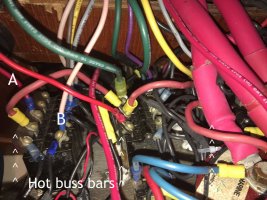The interior panel of my 1984 E381 is salvageable, if I clean up the mess back there.
This model used original Wood Electric/AMC 112 series circuit breakers. They're robust switches with metal toggles, and I recognize them from aircraft I used to fly.
They're no longer manufactured, but replacements are available at www.cmsquick.com .
Here's a question: which side of these breakers takes the connector?
As you can see in the photo, one side has a hot bus bar. Somebody put several appliances on that side.
But the factory put all the connectors on the other side. Which is correct?

This model used original Wood Electric/AMC 112 series circuit breakers. They're robust switches with metal toggles, and I recognize them from aircraft I used to fly.
They're no longer manufactured, but replacements are available at www.cmsquick.com .
Here's a question: which side of these breakers takes the connector?
As you can see in the photo, one side has a hot bus bar. Somebody put several appliances on that side.
But the factory put all the connectors on the other side. Which is correct?
Attachments
Last edited:

